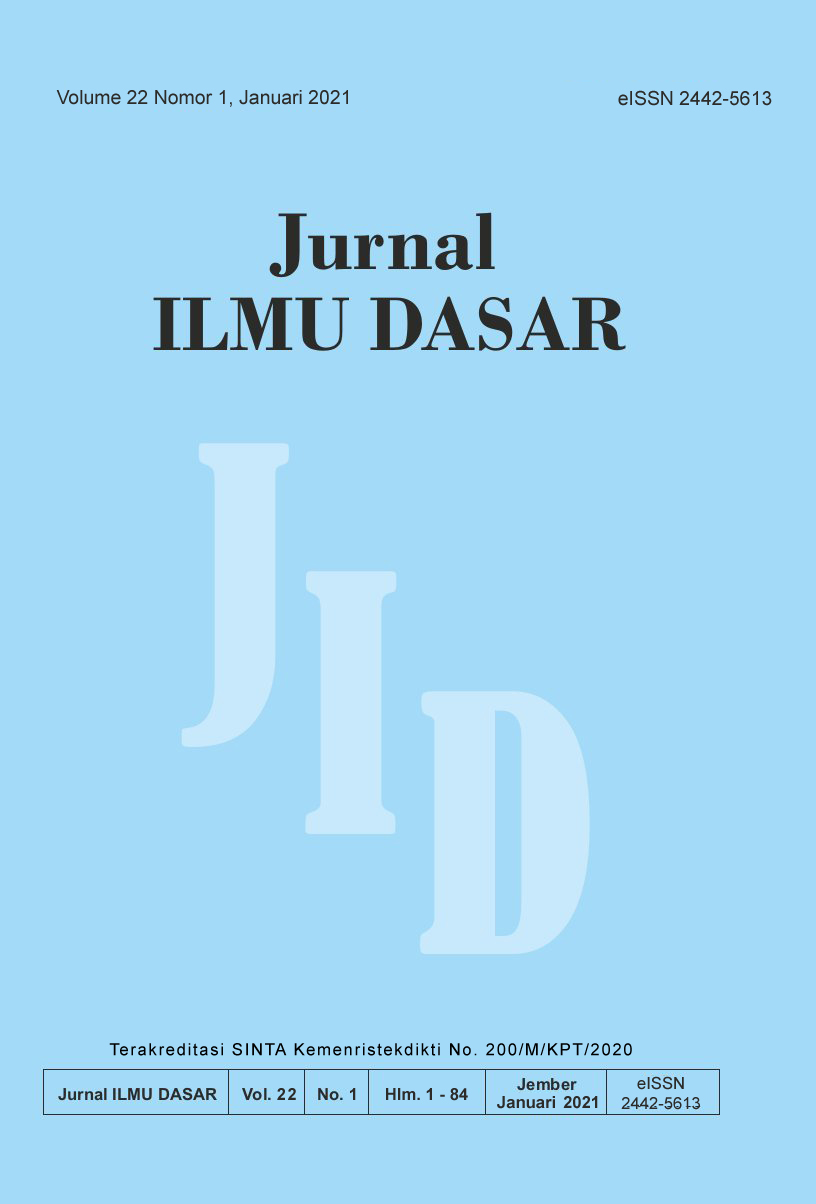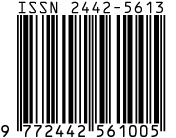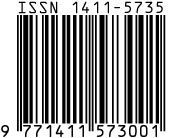Habitat Characteristic of Softshell Turtle (Amyda cartilaginea Boddaert,1770) in Engkelitau River Sekadau Regency, West Borneo
Abstract
Information about the character of softshell turtle’s habitat (Amyda cartilaginea) is needed as conservation effort and to prevent softshell turtle’s extinction. The research on habitat, morphometric holes, and environmental factors that suitable for softshell turtle is needed to be approved. The research was conducted in Engkelitau River, Sekadau, West Borneo. Sampling area was divided into 3 stations based on the type of cover between primary dryland forest, farming land and open field. Data on the softshell turtle’s number, holes and scratch marks were analyzed using principal component analysis (PCA). The highest river slope at Station I is 60o and the lowest river slope at Station III is 42o. Substrate’s type that found in Engkelitau River consist of sandy, dusty, and muddy substrates. The number of softshell turtle’s hole in the Engkelitau River is 45 holes, consisting one hole with softshell turtle, 15 holes with scratch marks, and 29 holes not including both of them. The highest height, width and distance between holes are in Station I and both hole’s length and height from the surface as well as highest river are in Station II. The environmental factors that affected A. cartilaginea in the Engkelitau River consisted of river velocity and river’s slope with loading factors of 4.08135 and 3.94019 respectively. The characteristics of A. cartilaginea’s hole in the Engkelitau River including a pond in the hole, an air hole, and located in the middle of a riverbank.
Keywords: habitat characteristics, Amyda cartilaginea, softshell turtle, Engkelitau river.
References
Amri K & Khairuman. 2002. Labi-labi Komoditas Perikanan Multi Manfaat, Jakarta. Agro Media Pustaka
Carriere MA, Bulte G & Demers GB, 2009. Spatial Ecology of Northern Map Turtles (Graptemys Geographica) in a Lotic and Lentic Habitat. Journal of Herpetology, 43(4): 597-604.
[CITES] Convention on International Trade in Endangered Species of Wild Fauna and Flora. 2010,
[CITES] Convention on International Trade in Endangered Species of Wild Fauna and Flora. 2004. Asian Freshwater Turtles. Species Survival Network, Washington DC.
[Ditjen PHKA] Direktorat Jenderal Perlindungan Hutan dan Konservasi Alam. 2007. Keputusan Direktur Jenderal Perlindungan Hutan dan Konservasi Alam Nomor: SK.33/IV-KKH/2007 tentang Kuota Pengambilan Tumbuhan Alam dan Penangkapan Satwa Liar untuk Periode Tahun 2007. Ditjen PHKA, Jakarta, Departemen Kehutanan Indonesia.
[Ditjen PHKA] Direktorat Jenderal Perlindungan Hutan dan Konservasi Alam. 2008. Keputusan Direktur Jenderal Perlindungan Hutan dan Konservasi Alam Nomor: SK.06/IV-KKH/2008 tentang Kuota Pengambilan Tumbuhan Alam dan Penangkapan Satwa Liar Yang Termasuk Apendix CITES untuk Periode Tahun 2008. Ditjen PHKA, Jakarta, Departemen Kehutanan, < http://ksdae.menlhk.go.id/peraturan/post/150> diakses tanggal 8 April 2018
[Ditjen PHKA] Direktorat Jenderal Perlindungan Hutan dan Konservasi Alam. 2009. Keputusan Direktur Jenderal Perlindungan Hutan dan Konservasi Alam Nomor: SK.148/IV-KKH/2009 tentang Kuota Pengambilan Tumbuhan Alam dan Penangkapan Satwa Liar Yang Termasuk Apendix CITES untuk Periode Tahun 2009, Ditjen PHKA, Jakarta, Departemen Kehutanan, < http://ksdae.menlhk.go.id/peraturan/post/150> diakses tanggal 8 April 2018.
Ernst CH & Barbour RW.1989. Turtles of The World, Turtle of Southeast Asia, Malayan Soft Shell Turtle Amyda cartilaginea.www.ecologyasia.com/verts/turtles/malayan-soft-shell-turtle.diakses tanggal 20 januari 2019
Farajallah A. 1995. Keragaman Genetik Labi-labi Dogania subplana (Testudines:Trionychidae) Berdasarkan Polimer Protein. Tesis. Bogor, Program Pascasarjana, IPB.
Iskandar DT. 2000. Kura-kura dan Buaya Indonesia dan Papua Nugini. Bandung, Institut Teknologi Bandung.
[IUCN] International Union for Conservation of Nature and Natural Resources. 2010. IUCN Red List of Threatened Species. www.iucnredlist.org. diakses tanggal 8 April 2018.
Lilly L. 2010. Population Characteristic of Harvested Amyda cartilaginea in Sambas Distric and Ketapang Distric. Tesis, West Borneo. Program Pascasarjana, Institut Pertanian Bogor.
Mardiastuti A & Soehartono T. 2003. Perdagangan reptil Indonesia di pasar international. Prosiding Seminar Hasil Penelitian. Bogor, Departemen Konservasi Sumberdaya Hutan, Institut Pertanian Bogor:131-144.
Mashar A. 2009. Karakteristik Morfologi, Struktur Populasi dan Karakteristik Telur Kura-kura Belawa (Amyda cartilaginea Boddaert 1977). Laporan Penelitian, Bogor, Departemen Manajemen Sumberdaya Perairan, Fakultas Perikanan dan Ilmu Kelautan, Institut Pertanian Bogor.
Restu W & Negara, WKI. 2016. Kajian Potensi dan Sebaran Sumberdaya Hayati Labi-labi (Amyda cartilaginea, Boddaert, 1770) di Bali, Laporan Akhir. Program Studi Manajemen Sumberdaya Perairan Fakultas Kelautan Dan Perikanan Universitas Udayana, Bali.
Sari M. 2012. Characteristic of Catchment Habitat and Demographic Parameter of Harvested Population of Amyda cartilaginea (Boddaert 1770) in Central Kalimantan Province. Tesis, Institut Pertanian Bogor (IPB), Bogor.
Sekadaukab. 2012. Wilayah Adat Tapang Sambas Tapang Semadak. http://www.brwa.or.id/wa/view/ZkFsazB0SHIzLUk. diakses tanggal 20 Juli 2018.
Sentosa A & Suryandari A. 2016. Sebaran Ukuran Morfologi Labi-Labi (Amyda cartilaginea Boddaert, 1770) Hasil Tangkapan di Sumatera Selatan. Jurnal Penelitian Perikanan Indonesia. 20(3):129-136.
Septia R. 2019. Karakteristik Sarang Peneluran Labi-Labi (Amyda cartilaginea) di Sungai Indragiri Desa Lubuk Terentang Kecamatan Gunung Toar. Jurnal Ecology. Fakultas Perikanan dan Kelautan Universitas Riau, Pekanbaru.
Setyobudiandi I. 1997. Studi Habitat dan Distribusi Penyu Air Tawar (Amyda cartilaginea) di Kabupaten Bogor. Abstract. Lembaga Penelitian dan Pengabdian kepada Masyarakat, Institut Pertanian Bogor.

This work is licensed under a Creative Commons Attribution-ShareAlike 4.0 International License.












